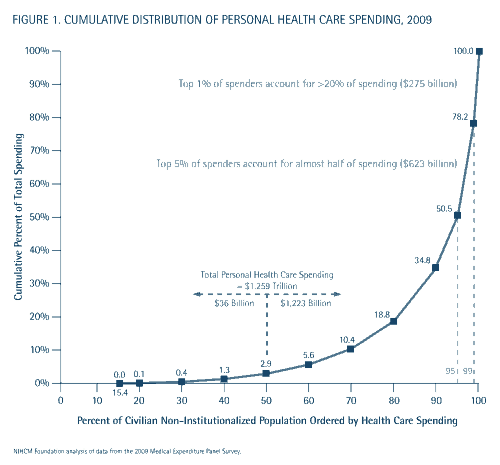When Aaron showed this chart,
readers wondered what might be done to reduce costs where it counts, for the minority of patients that account for the majority of health spending. In another gem, Atul Gawande arrives at some answers, by way of analogy to the efficiency of meal production at the Cheesecake Factory.
The question is whether the medical counterparts to Mauricio at the [Cheesecake Factory] broiler station—the clinicians in the operating rooms, in the medical offices, in the intensive-care units—will go along with the plan. Fixing a nice piece of steak is hardly of the same complexity as diagnosing the cause of an elderly patient’s loss of consciousness. Doctors and patients have not had a positive experience with outsiders second-guessing decisions. How will they feel about managers trying to tell them what the “best practices” are?
No question, many will detest it and fight it with all their might. But some will not. To what end? Gawande offers a few examples, such as:
The surgeons now use a single manufacturer for seventy-five per cent of their [knee replacement] implants, giving the hospital bargaining power that has helped slash its knee-implant costs by half. And the start-to-finish standardization has led to vastly better outcomes. The distance patients can walk two days after surgery has increased from fifty-three to eighty-five feet. Nine out of ten could stand, walk, and climb at least a few stairs independently by the time of discharge. The amount of narcotic pain medications they required fell by a third. They could also leave the hospital nearly a full day earlier on average (which saved some two thousand dollars per patient).
The whole thing is worth a read. I know it is long, but the part near the end about Steward’s ICU command center is not to be missed.
For all that, I doubt the shape of the distribution of health spending will change much. The sicker will account for vastly more spending, relative to the healthy, even if it is at an overall lower level than it otherwise would be. That’s as it should be. But if dollars are spent for more efficient care, my guess is that more of us will be satisfied with a greater amount of health spending than we would otherwise. We may reasonably conclude we’re getting a perfectly fine deal, that it is worth the price.
We should all be for quality and efficiency. Isn’t that what you’d want for yourself in the ICU anyway, even at lower cost and most especially at a high cost?



